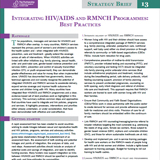
Strategy Brief 13
Rationale
The populations, messages and services for HIV/AIDS and RMNCH often overlap. In many countries, RMNCH services represent the primary point of women’s and children’s access to the health system and – when integrated with HIV/AIDS prevention, care and treatment – greatly extend the coverage across all sets of interventions.
When HIV/AIDS activities are linked with other initiatives (e.g. family planning, sexual health, ante- and post-natal care, gender-based violence prevention and services (GBV), prevention and control of sexually transmitted infection (STI), or youth empowerment), they can demonstrate greater effectiveness and value for money than when implemented alone. UNAIDS has documented how governments, donors, technical agencies and civil society recognise the potential of integrated HIV/AIDS and RMNCH services to accelerate delivery, expand service coverage and improve health outcomes for women and children living with HIV. Many countries have integrated their HIV/AIDS and RMNCH programmes and a clear, evidence-based set of best practices exist as highlighted in this summary.
This summary outlines common steps and approaches that countries have used to integrate and link policies, programs and services. It highlights processes, interventions and priorities either already undertaken, or under consideration, that have been demonstrated both effective and cost-effective.